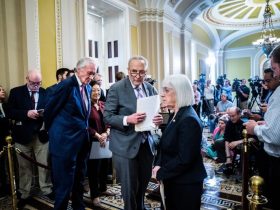After weeks of touch-and-go negotiations that culminated in a bipartisan deal, the House is set to vote Wednesday night on a bill to suspend the debt ceiling, as lawmakers rush to wrap up the legislation and avoid a disastrous default before June 5 — the day the government would default without a new borrowing cap.
The final bill — brokered over the weekend by President Biden and House Speaker Kevin McCarthy (R-Calif.) — has faced staunch criticism from far-right Republicans and some progressive members of Congress. On the right, members of the House Freedom Caucus have blasted McCarthy for compromising with Biden and not securing steeper spending cuts. And on the left, more-progressive members are dismayed that the deal imposes new work requirements for certain federal programs.
But the bill is expected to advance even if some lawmakers on opposite ends of the political spectrum vote against it. McCarthy needs the support of a “majority of the majority,” or at least half of the 222 Republicans in the House, to bring the bill to the floor, under unofficial GOP guidelines. That means he can lose up to 111 of his own party members, but the bill would then need up to 107 Democratic votes.
Speaking to reporters on Tuesday, McCarthy was confident he could deliver.
“It’s the most conservative deal we ever had,” McCarthy said. “Sometimes people just don’t want to vote for a debt ceiling.”
House Minority Leaders Hakeem Jeffries (D-N.Y.) told reporters on Tuesday that he expected GOP lawmakers to “keep their promise and deliver at least 150 votes.” Jeffries has repeated that message not because Democrats lack the votes on their end, but because McCarthy stressed throughout negotiations that he could get that many Republicans to support the deal, according to two people familiar with the Democratic leader’s thinking who spoke on the condition of anonymity to describe party strategy.
What happens if the U.S doesn’t raise the debt ceiling?
End of carousel
If the bill passes the House, it would head to the Senate for a vote. Senate Majority Leader Charles E. Schumer (D-N.Y.) has said lawmakers may need to be in Washington through the weekend to get the legislation passed before June 5, when the Treasury Department has warned the United States would no longer be able to pay all of its bills.
Regardless of a final vote count, the debt ceiling drama has exposed deep opposition toward McCarthy from some far-right Republicans lawmakers, including those who say he is not fit to be speaker. Asked Tuesday how much confidence he had in McCarthy, Rep. Dan Bishop (R-N.C.), a member of the Freedom Caucus, said “none.”
“The Republican conference right now has been torn asunder,” Rep. Chip Roy (R-Tex.), who has come out strongly against McCarthy’s leadership, said at a news conference Tuesday. “And we are working hard to try to put it back together again this weekend.”
That did not stop Republican or Democratic leadership from aggressively whipping support for the bill. Between conference calls, news conferences and in-person meetings, both parties are attempting to sell the deal as a win for their constituencies, no matter the concessions made.
For instance, Rep. Pramila Jayapal (D-Wash.), the leader of the House Progressive Caucus, said Tuesday that the group is still talking to its members to see where they stand so lawmakers can decide whether they will endorse the deal as a unit.
“Negotiations require give and take,” White House spokeswoman Karine Jean-Pierre told reporters Tuesday. “No one gets everything that they want. That’s how divided government works. But the president successfully protected core Democratic priorities and the historic economic progress that we have made over the last two years. Now, the House and the Senate, it’s up to them.”
The bill passed a crucial procedural test on Tuesday, when the House Rules Committee cleared the way for the bipartisan deal to come before the full chamber. Initially, attention was fixed on a handful of far-right committee members who could have thwarted the bill’s future by voting against it there. But by Tuesday evening, Rep. Thomas Massie (R-Ky.), a libertarian-minded conservative who sometimes sides with the Freedom Caucus, indicated he would vote to move the bill forward, giving Republicans enough support to adopt the rule and handing a win to GOP leadership.
The deal raises the debt ceiling for two years and allows the government to pay its bills without a hitch if signed into law before June 5. In a concession to Republicans, the plan limits domestic spending for two years and impose some new work requirements for certain individuals receiving food stamps and those in the Temporary Assistance for Needy Families program. It also would pare back roughly $20 billion of the $80 billion approved last year for an expansion of the IRS.
Democrats, meanwhile, are touting that White House negotiators did not give into Republican demands for steep cuts on domestic spending. The deal would also raise the debt ceiling beyond the 2024 election.








